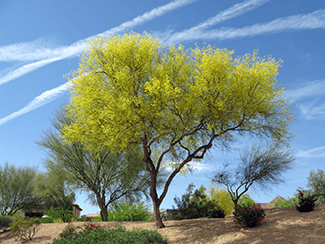Discovering The Palo Verde Beetle
This is the time of year those big, black beetles take to the air. These bugs are sometimes thought to be cockroaches but, they are a very different creature unique to the desert southwest. These beetles, known as Palo Verde Beetles, appear about the same time summer arrives and continue through the monsoon.
Creepy Encounters | What To Do When I Encounter A Palo Verde Beetle?

It can be very threatening when a Palo Verde Beetle comes winging your way as they can grow up to 5 inches long – almost as big as a small drone. They are attracted to light, so you are most likely to see them in the evening when the patio lights are on. They are not particularly graceful fliers and they lack landing skills. In fact, they crawl more often than fly. If one is airborne and lands nearby, you may hear it thwack on the concrete behind you!
There is no need to panic! Palo Verde Beetles don’t bite, and they are not even looking for food. If you pick one up however, you may get a surprise pinch from the front mandibles. John Eisenhower, of Rosie Certified SavATree says, “if you’re adventurous, they move slowly and are easy to pick up and examine. Though the mandibles are strong enough to break a small pencil, they are very docile and harmless. Just be sure to pick them up behind the front legs away from the pinchers.”
It’s A Short Life:
It may seem like they come out of nowhere, but the larvae of a Palo Verde Beetle live, unnoticed for about 3 years, eating voraciously at the roots of your tree. In June and July, the larvae turn into adult beetles and exit the ground via small holes. They are only alive for a short season and they are on a mission to mate. Once they mate, the female crawls underground to lay her eggs and the adults die. These beetles have a taste for Palo Verde trees but can also be found in the root zones of other trees such as pines, mesquite, and ironwoods.
Signs That Your Tree Is Infested with Palo Verde Beetles:

Healthy trees may never show signs of infestation. The insects may be underground, but they are not destroying enough roots to have an impact on the health of your tree. Stressed trees suffer the most damage by the beetles. Trees hit by numerous larvae can also suffer damage. A sign that Palo Verde Borers are active is the dying off of individual branches or tips dying back on multiple branches. Unfortunately, by the time you see the above ground damage, the damage below ground can be extensive.
Eisenhower tells us that the closer the beetles are to the trunk and large scaffold roots of the tree, the more damage they can do.
Is There A Cure for My Tree?

Currently, there is little that can be done to control these beetles. Because there is so much soil volume to treat, pesticide applications may have limited success. The beetles often attack stressed trees; a good way to protect your trees from succumbing is to keep your trees as healthy as possible by providing adequate water and fertilizer.
If you choose to use pesticides, target the root zone within 4 to 6 feet from the tree to protect the root collar and major scaffold roots.
###
Outdoor Living: #SummerPests #TreeHazards&Risk #TreeHazards
















